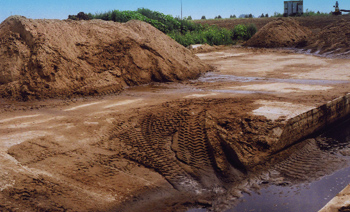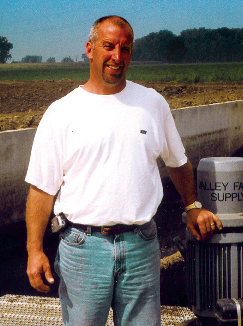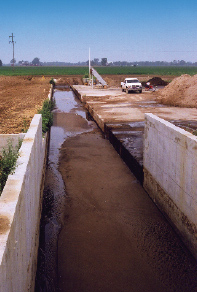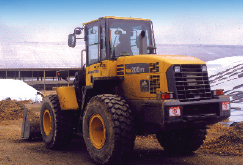
Michigan dairyman Tony Jandernoa
has installed a sand lane to separate sand from manure, a move that
helps his dairy operation deal with manure management now and positions
it well for possible expansion in the future.
 The loader goes down the sloped ramp to pick up the sand in the lane and moves it on to the concrete pad. The loader goes down the sloped ramp to pick up the sand in the lane and moves it on to the concrete pad. |
Michigan dairyman Tony Jandernoa has installed a sand lane to separate sand from manure, a move that helps his dairy operation deal with manure management now and positions it well for possible expansion in the future.
You can sure tell that things have changed in the dairy industry—especially when dairy producers get together. Dairymen used to focus on milk production, and perhaps barn and milk parlor set-ups. These days, manure management seems to be the most talked-about topic.
“I’d say that manure management is the number one issue in the industry,” says Michigan dairy farmer Tony Jandernoa. “The government, environmental groups and the public all want to know what we are doing with our manure.”
Jandernoa was happy to share exactly what he does with manure on his dairy farm, Dutch Meadows Dairy, at the recent Great Lakes Manure Expo. The Manure Expo was held this past July at the Berlyn Acres Farm, near St John’s, Michigan. More than 1,100 people turned out for the event, which further underscores the fact that manure management is a top priority for the industry.
Interested farmers from 10 states attended sessions on manure land application topics including: hauling costs; value of manure nutrients; odor; GPS technologies; composting; keeping manure out of tile drain systems; and dealing with sand laden manure.
 Tony Jandernoa of Dutch Meadows Dairy notes that in terms of support equipment, the sand lane system is very simple. It requires only two 20 horsepower Valley Farm Supply shaft turbine pumps, one for flushing and the other for moving material to the lagoons. Tony Jandernoa of Dutch Meadows Dairy notes that in terms of support equipment, the sand lane system is very simple. It requires only two 20 horsepower Valley Farm Supply shaft turbine pumps, one for flushing and the other for moving material to the lagoons. |
Jandernoa spoke at the panel session on dealing with sand laden manure—a topic he’s very familiar with. And it’s a challenge to which he’s come up with a solution. The solution he chose is more often implemented in warmer dairy states like California than it is in the US Midwest: building a sand lane to separate the sand from the manure. It’s simple, cost-effective and—most important of all—it’s doing the job.
Jandernoa notes that there is a lot of pressure on dairy farmers to manage their manure properly which, of course, is not necessarily a bad thing. In fact, he feels that this pressure, even though it may be excessive at times, is probably responsible for some of the innovation and different ideas that farms are looking at implementing.
In the case of Jandernoa’s Dutch Meadows Dairy, the 800-cow operation lies between two small communities about 90 minutes northwest of Detroit. It is not facing the urban encroachment that other dairies, closer to major centers, have to deal with. By and large, neighbors understand that it is a dairy farm, and with that comes odors.
There were occasional comments about odor. Before the sand lane and associated lagoon system was put in place, the dairy was hauling every second day. But it was really a desire to move ahead with a more modern manure management system, as well as planning for the future, that drove the decision to install a sand lane system.
Pending Michigan regulations also had a role to play. “It was looking like we weren’t going to be able to haul in the winter after 2007,” explains Jandernoa. “I was looking at these regulations down the road, and knew that we have to move things ahead. That was the big push.”
And there was no question about changing things at the dairy in terms of their bedding material. They’ve been working with a sand bedding system since 1999, and it continues to deliver on all counts—cow comfort, with no problems with mastitis or somatic cell counts. Sand bedding works for this operation, big time.
The farm had worked with a mechanical separation system before, but Jandernoa says it was not a good experience. The separation system required a lot of maintenance, and they had a hard time keeping it going. After giving it a good go, they decided to go back to hauling every other day. With every other day hauling, the farm operation was kind of under the gun—there was little in the way of manure storage, so they had to haul that often. “We hauled unless it was absolutely too wet—only then would we fire the separator up and try to get it working.”
Last fall, though, Jandernoa started work on the project that would change things, and position the farm for the future and for possible expansion.
The planning for the sand lane started then, and construction went into full gear early in 2006 and into the spring. Equipment from T H Miller Excavating was out at the farm, digging additional lagoon capacity, and concrete trucks were making regular visits, doing the pours for the sand lane. The work actually started last fall, but extended into the new year and the spring, due to wet and cold weather.
 Dutch Meadows has a 300-foot long, 12-foot wide concrete lane that is now doing a very effective job of separating the sand from the manure stream. “Getting the sand out was critical to the whole process,” says Tony Jandernoa. “Now I can manage the manure, not the sand.” Dutch Meadows has a 300-foot long, 12-foot wide concrete lane that is now doing a very effective job of separating the sand from the manure stream. “Getting the sand out was critical to the whole process,” says Tony Jandernoa. “Now I can manage the manure, not the sand.” |
The end result is that Dutch Meadows now has a 300-foot long, 12-foot wide concrete lane that is doing a very effective job of separating the sand from the manure stream, along with a three-stage lagoon system. The existing six million gallon lagoon was expanded to eight million gallons, and two additional lagoons, with capacities of two million and three million gallons respectively, were added.
Rather than doing every other day hauling, they will now have the relative luxury of hauling three times a year—spring, summer and in the fall.
“Getting the sand out was critical to the whole process,” explains Jandernoa. “Now I can manage the manure, not the sand. That was our goal. Being able to re-use the sand as bedding material is a pure bonus.” Sand recovery is well into the 90 percent plus range. “At this point, I don’t know the recovery percentage exactly, but I’m happy with what we are able to get out. An awful lot of the sand is staying right there in the lane, which is what it is all about.”
It’s a significant improvement over the one lagoon system in place previously. “We never wanted to put sand laden manure in there. It did not have a cement bottom, so it was a matter of if you put the sand in there, how do you get it out?” Add to that is the grief that sand causes to pumps and other equipment.
But on April 28—Jandernoa notes the day with pride—all that ended. “That’s when we started things up with the sand lane.”
There have been a few hiccups and surprises since then. “The organics surprised me a little bit, they separated a little bit more than I expected. And in hindsight, I’d do a few things differently, like put a little bit of slope in the sand lane. But for the most part, I’d have to say things went really well.”
They had to make some changes equipment-wise. The original plan was to use the farm’s skid steers to move the sand out of the sand lane and on to the adjacent concrete pad. But the large volumes of wet sand were more than they could handle. “When that sand packs in tight, it’s like moving concrete,” says Jandernoa. So they opted for a front end loader, and now have a Komatsu WA 200PT, equipped with a three cubic yard bucket, doing this work. “There was a cost to that,” says Jandernoa. “But it really works great.”
The loader cleans out the sand lane every three or four days, which usually takes about two hours. The loader goes down a sloped ramp to pick up the sand in the lane and then dumps it on the concrete pad. At any point, they will have several piles of sand drying, and will move the sand around from one pile to another, to help dry it more effectively. The sand dries out and is ready for re-bedding in about two weeks.
And after drying, the sand going back in the barns is “beautiful,” he says. “When I was at the Manure Expo conference talking about the system, people were asking questions about mastitis and somatic cell counts. We haven’t seen those issues yet, and I don’t think we are going to see them because that sand is so clean.”
 Sand from the sand lane is removed using a Komatsu front end loader, equipped with a three cubic yard bucket. Sand from the sand lane is removed using a Komatsu front end loader, equipped with a three cubic yard bucket. |
And in terms of support equipment, the system is simplicity itself. Jandernoa has two 20 horse power Valley Farm Supply shaft turbine pumps, one for flushing and the other for moving material to the lagoons.
“That’s it,” he says. “There’s really not much there to wear out. That’s really what intrigued me about the system: it’s very low maintenance. The concrete lane will probably be there forever.” On a large dairy operation where there is no shortage of things to do, low maintenance is a good thing, he adds.
Being able to get away from almost daily manure hauling will give the farm more control over manure application, and perhaps allow them to tweak its use as a nutrient on their 1,800 acres. Like all dairy operations in Michigan, they have a Comprehensive Nutrient Management Plan (CNMP), which was initially put together by Silvernail Consulting, of Dewitt, Michigan, and it is updated annually. In one way, the CNMP just formalized the prudent manure application program Dutch Meadows already had in place. But in other ways, it helps to better measure and apply nutrients. “We now know more exactly what we are applying to the fields, and we can pay closer attention to the nutrients we are putting out there,” says Jandernoa.
“Our ultimate goal is to make maximum use of the manure as a nutrient.” Jandernoa notes the rising cost of commercial inputs, like nitrogen, is also an incentive.
They currently do surface application using Angus hose and a home-made toolbar, but they’re going to look at doing some injection. “I’d like to change things a little more and I’m sure we will, perhaps with injection. But surface application is so easy and fast. There are advantages to injection, but there’s a cost to it.” Spreading is done with a Meyer 8500 Spreader.
Jandernoa notes that manure and nutrient management seems to be an evolving process—you can get one thing done, and then there’s always something else that you can look at doing. And regulations are always changing.
A local company, Harvey Milling Co of Carson City, Michigan, helps keep track of their manure application. During application, equipment operators write down the information, and it is passed on to the company, which enters it into a database system. “They help with the soil sampling and making sure the nutrients are balanced so we’re getting the most out of the manure.”
Being a successful dairy operation sometimes comes down to knowing what work can—and should—be delegated. And Jandernoa is happy to delegate this work to the specialists at Harvey Milling. “These guys are the experts in this area. When it comes down to running a dairy, you can’t do it all. I don’t have the time or the desire to do this, but these guys know all about what I need to do for nutrient management from the get-go. I get help from them just like I get help managing the cows.”
Overall, at this point, Jandernoa is pleased with the move to the sand lane, even though it represented a relatively large outlay of capital. “The main thing is it’s working well. And the recovered sand is very clean. We’ve run some tests on it, and the volatile solids are running just a big higher than fresh sand. There’s not a lot of difference.”
The capital outlay for the sand lane pales in comparison with the money that would be required for a more involved manure management system such as digesters. “Some dairies can afford digesters, but it’s really not a practical solution for most dairies,” he says.
Jandernoa notes that while his sand lane setup is a simple system, it will likely evolve. And he is quick to give credit to the dairy farmers who have already established sand lane systems for doing pioneer work in this area, which he was able to benefit from. In fact, he notes, his system is basically modeled after a California operation. “It looked very efficient and does a nice job.” The California system was bit longer, at 500 feet, but then the dairy there has 2,400 cows. “The one we have is smaller, but the principles of the system are the same.”
Jandernoa again emphasizes the simplicity of the system. “I did not want complicated. I wanted a very simple system and I like to think that’s what we have.”
All of this positions Dutch Meadows Dairy for a possible expansion. They initially started out with 100 cows and now have 800 cows. The profit margins in dairy can be pretty slim, and it is coming down to being a game of volume. “I think we are eventually going to go up to 1,500 cows and I wanted to have a manure system in place before going down that road,” says Jandernoa.
“I want to be able to manage the manure we have now, and the manure we would have in the future if we expand. With the sand lane, it really doesn’t matter how many cows we have—it’s going to work the same. If we go bigger, it just means we have to clean the lane out more often.”